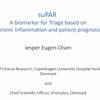Frank Tacke, MD, PhD, University Hopsital Achen, Germany: Diagnostic and Prognostic Value of suPAR at the Medical ICU
suPARnostic See all
Dr Tacke discuss suPAR results at the 2’nd International suPAR Symposium
Crit Care. 2011;15(1):R63. Epub 2011 Feb 16.
Circulating soluble urokinase plasminogen activator receptor is stably elevated during the first week of treatment in the intensive care unit and predicts mortality in critically ill patients.
Koch A, Voigt S, Kruschinski C, Sanson E, Dückers H, Horn A, Yagmur E, Zimmermann H, Trautwein C, Tacke F.
SourceDepartment of Medicine III, RWTH-University Hospital Aachen, Pauwelsstrasse 30, 52074 Aachen, Germany.
Abstract
INTRODUCTION: suPAR is the soluble form of the urokinase plasminogen activator receptor (uPAR), which is expressed in various immunologically active cells. High suPAR serum concentrations are suggested to reflect the activation of the immune system in circumstances of inflammation and infection, and have been associated with increased mortality in different populations of non-intensive care patients. In this study we sequentially analyzed suPAR serum concentrations within the first week of intensive care in a large cohort of well characterized intensive care unit (ICU) patients, in order to investigate potential regulatory mechanisms and evaluate the prognostic significance in critically ill patients.
METHODS: A total of 273 patients (197 with sepsis, 76 without sepsis) were studied prospectively upon admission to the medical intensive care unit (ICU), on Day 3 and Day 7, and compared to 43 healthy controls. Clinical data, various laboratory parameters as well as investigational inflammatory cytokine profiles were assessed. Patients were followed for approximately one year.
RESULTS: Upon admission to the ICU suPAR serum concentrations were elevated in critically ill patients as compared with healthy controls. In sepsis patients suPAR levels were higher than in non-sepsis patients (with or without systemic inflammatory response syndrome (SIRS)). During the first week after admission to the ICU serum suPAR concentrations remained stably elevated. suPAR serum concentrations measured upon admission were closely and independently correlated to various laboratory parameters, specifically biomarkers of inflammation (tumor necrosis factor (TNF), C-reactive protein (CRP)), hepatic and renal dysfunction. High suPAR levels at admission and at Day 3 were a strong independent predictor for both ICU and long-term mortality in critically ill patients.
CONCLUSIONS: In sepsis and non-sepsis patients suPAR serum concentrations are increased upon admission to the ICU, likely reflecting the activation state of the immune system, and remain stably elevated in the initial course of treatment. Low suPAR levels are a positive predictor of ICU- and overall survival in critically ill patients, including sepsis and non-sepsis patients. Aside from its value as a promising new prognostic biomarker, both experimental and clinical studies are required in order to understand the specific effects and regulatory mechanisms of suPAR in SIRS and sepsis, and may reveal new therapeutic options.
Officel welcome words at the conference:
Dear Colleagues
On behalf of the scientific committee, it is my pleasure to welcome you to “The 2nd International Conference on suPAR” taking place in early spring 2011 at the Danish National Museum in Copenhagen.
The 1st International conference on suPAR” in 2003 shared findings on suPAR as a marker of disease progression and survival in HIV and TB infected. Since then, suPAR has been broadly applied to a range of diseases and the same picture is emerging. An elevated suPAR is associated with a negative prognosis independent of disease. Even among the general population, an elevated suPAR has recently been shown to be associated with increased risk of diseases such as cardiovascular disease, cancer and Type 2 Diabetes.
But what does an elevated suPAR reflect? The suPAR level is positively correlated with markers of inflammation and immune activation such as CRP (hsCRP), TNF-a and white blood cell counts. Thus, suPAR may be a novel marker of inflammation, and increased inflammation has in recent years been suggested as a disease driving mechanism. Nevertheless, suPAR remains associated with disease endpoints after the adjustment of other inflammatory markers and is less related to metabolic variables than CRP. Thus suPAR may reflect another aspect of inflammation than the classical markers do.
A large number of studies are currently investigating the role of suPAR in a wide variety of conditions, and this conference will bring forward the newest data which will further enlighten the role and possible applications of this biomarker.
We look forward to sharing these exciting data and to welcome you to the heart of Copenhagen
Sincerely
Jesper Eugen-Olsen, PhD, conference chairman
Laboratory research director,
Copenhagen University Hospital, Hvidovre
Purpose and Scope
The suPAR (soluble urokinase Plasminogen Activator Receptor) protein is a relatively new biomarker which has ability to predict severity of illness and mortality. The prognostic value of suPAR has been described in published studies in recent years and is currently being tested in several health care applications.
The symposium aim is to bring together researchers, users and other persons to discuss the features and potential usability of the suPAR protein as a biomarker and will:
◦Provide a forum to learn about new findings and current suPAR studies
◦Host a scientific community discussion on the new opportunities that exist with a prognostic biomarker
◦Hear from the delegates what questions, feed-back and ideas for suPAR applications and user requirements
◦Facilitate foundation for international net-working
suPARnostic See all
Dr Eugen-Olsen talks on chronic inflammation and how it is linked to the...
|
|||||










































































































